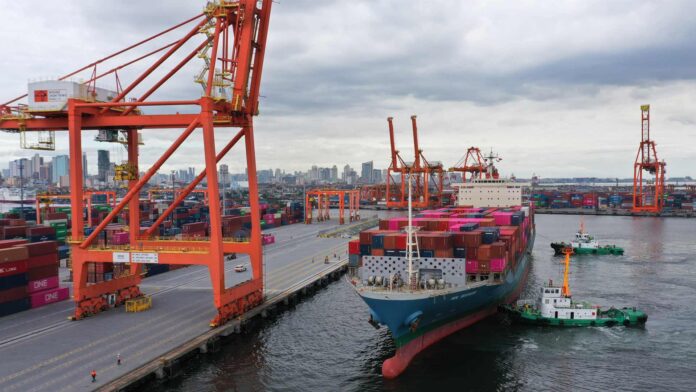
-
Annual capacity of Manila International Container Terminal raised to over 3.3 million twenty-foot equivalent units with completion of berth expansion
-
The expansion added another 150 meters to Berth 7, creating a 600-meter contiguous berth with the adjacent Berth 6 to accommodate over 8,000-TEU capacity vessels
-
Project is complemented by extension of the container yard by another 5.5 hectares
-
Equipment replacement program and refurbishing of Berths 1 to 5 and their backup areas are also being implemented at the terminal
International Container Terminal Services, Inc. (ICTSI) has completed a berth expansion project at Manila International Container Terminal (MICT), effectively raising the annual capacity of the port operator’s flagship terminal to over 3.3 million twenty-foot equivalent units (TEU).
The expansion added another 150 meters to Berth 7, creating a 600-meter contiguous berth together with the adjacent Berth 6 to accommodate over 8,000-TEU capacity vessels, ICTSI said in a statement.
The two berths currently have five quay cranes, with a design for up to six quay cranes.
Complementing the berth expansion is the extension of the container yard by another 5.5 hectares, of which 3 hectares are designated for laden containers and 2.5 hectares for empty containers. This translates to added capacity for the terminal of an estimated 200,000 TEUs for laden containers and 150,000 TEUs for empties.
ICTSI executive vice president Christian Gonzalez said the added berthing capability and yard space will enable easy handling of the expected additional volume, as the country’s economy reboots following last year’s trade flow disruptions due to COVID-19.
“Moreover, this will enable us to continue performing our tasks as frontliners to move critical goods that are still badly needed,” he said.
ICTSI said the additional berth space was completed on time and on budget despite limitations caused by the pandemic, with strict safety and health protocols implemented throughout the project construction and completion.
MICT executive director and chief executive officer Anders Dommestrup said the project, along with others being implemented, is aimed at easing business activities and transactions at the port.
“We will continue to invest in terminal facilities to improve our capacity, infrastructure and environmental footprint to provide the highest level of service,” Dommestrup said.
To further improve service levels, MICT, under its equipment replacement program, plans to acquire another eight environmentally friendly hybrid rubber tired gantries (RTG) next year to augment the 32 hybrid RTGs acquired starting in 2018.
The replacement program includes dismantling MICT’s first quay crane this year, to be replaced over the next three years by three new quay cranes, all capable of servicing larger vessels of over 12,500-TEU capacity.
Meanwhile, MICT is also refurbishing Berths 1 to 5 and their back-up areas in preparation for the next 25 years of operation. Work includes installing an additional 450 reefer plugs, expected to be operational by April this year, for 40-footers; refurbishing Berths 1 to 4 by September this year; and upgrading the yard infrastructure of Berths 1 to 5 by the end of 2022.
In addition, MICT will upgrade the entire terminal this year to the newest and more environment-friendly LED lighting system. This is expected to eliminate light spills and glare while lowering energy consumption by as much as 75%. ICTSI said the new lighting system will also provide a safer traffic environment with improved lux-levels of five to eight times.
By April this year, an additional truck ingress, equipped with optical character recognition, will be operational with additional automation to further improve gate service.
ICTSI said MICT continues to engage with the Bureau of Customs to reduce releasing time from the filing of entry and conducting more seamless X-ray and inspection procedures to ensure unimpeded and online release of cargo.




